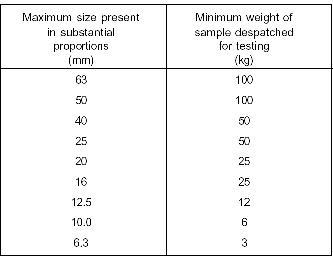SIEVE ANALYSIS
Sieve analysis helps to determine the particle size distribution of the coarse and fine aggregates.This is done by sieving the aggregates as per IS: 2386 (Part I) – 1963. In this we use different sieves as standardized by the IS code and then pass aggregates through them and thus collect different sized particles left over different sieves.
The apparatus used are –
i) A set of IS Sieves of sizes – 80mm, 63mm, 50mm, 40mm,31.5mm, 25mm, 20mm, 16mm, 12.5mm, 10mm, 6.3mm,4.75mm, 3.35mm, 2.36mm, 1.18mm, 600µm, 300µm, 150µm and 75µm.
ii) Balance or scale with an accuracy to measure 0.1 percent of the weight of the test sample.
The weight of sample available should not be less than the weight given below:-

The sample for sieving should be prepared from the larger sample either by quartering or by means of a sample divider.
Procedure to determine particle size distribution of Aggregates.
i) The test sample is dried to a constant weight at a temperature of 110 + 5oC and weighed.
ii) The sample is sieved by using a set of IS Sieves.
iii) On completion of sieving, the material on each sieve is weighed.
iv) Cumulative weight passing through each sieve is calculated as a percentage of the total sample weight.
v) Fineness modulus is obtained by adding cumulative percentage of aggregates retained on each sieve and dividing the sum by 100.
Reporting of Results
The results should be calculated and reported as:
i) the cumulative percentage by weight of the total sample
ii) the percentage by weight of the total sample passing through one sieve and retained on the next smaller sieve, to the nearest 0.1 percent. The results of the sieve analysis may be recorded graphically on a semi-log graph with particle size as abscissa (log scale) and the percentage smaller than the specified diameter as ordinate.
If you have a query, you can ask a question here.



Dear sir, i want to know d apparatus used in fine aggregate with their descriptions & photo graphs
Pls i’d like to get the Britsh standard codes for seive analysis of fine aggregate
i need seive analysis method,limitation&report of 10mm,20mm&course sand in detail also permissible limit
what is the procedure to combine the aggregates from individual gradings. Thank you
good crisp answers
why are we taking aggregate size corresponding to 60% and 10% finer to calculate uniformity coefficient
please furnish M30 concrete mix usuing cement grade 32.5
hello sir plz tell me the fine n course aggregate ranges
dear sir iwant to do this course of laboratory technician course as well as need notes
i want to know that why we add 500/100 in total cumulative % retained to calculate the fineness modulus of coarse aggregate
Sir, I would love to know the relationship of sieve analysis to petroleum engineering. Thank you.
I want to know seive analysis method, limitation & report of 10mm,20mm & course sand OR river sand test in details and also know about the permissible limit.
thanks and best regds
Siddiqui
What is the significance of ten percent fines value in testing sub-base material?
Sir, i want to know the method of sieve analysis for stone ballast size 22.4-50 mm,45-63 mm and 45-90 mm
how to use sieve analysis to determine the sediment grain size design ?
I am very greatfull for the info. On this site. Sir,want to know the if there is a particular weigth that each sieve size must retain. And the procedure for calculation after conducting sieve test.
this site is best
I WANT THE DETAILS REGARDING SIEVE ANALYSIS AND ABOUT CEMENT,CONCRETE.
Sir please help me, what are the precaution should be taken during laboratory test of sieve analysis of aggregates
i would like to the significance of coarse aggregate of size above 20mm on the strength of self consolidating concrete